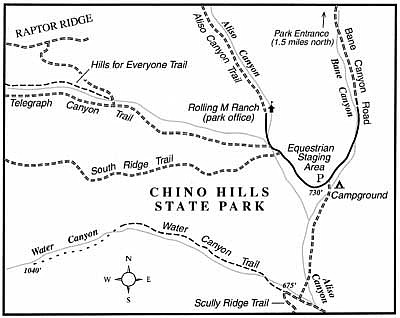 Facebook
Facebook
 X
X
 Instagram
Instagram
 TikTok
TikTok
 Youtube
Youtube
Chino Hills State Park spreads across some 13,000 acres of rolling, grassy hills of a sensuous, classically Californian nature. Down in the moist, hidden hollows between the swelling hills, live oak and California walnut trees thrive in sheltering habitats free from excessive sunlight and heat. State-park status is protecting these hills and ravines from the snarling, earth-moving machines that are rapidly transforming the vast "Inland Empire" region of Southern California into a mega-suburb of Los Angeles.
If you want to visit what is perhaps the single most isolated yet decently accessible spot in the Chino Hills, visit Water Canyon. Concealed in the inky depths of this steep-walled ravine, massive sycamores and oaks reach skyward, casting a perennial chill. Except for the occasional buzz of a small aircraft and the rustle of leaves in the breeze overhead, the silence and stillness are absolute.
Chino Hills State Park has a temporary main entrance that is about as obscure as the park itself. From the Riverside Freeway (Highway 91) in Corona, drive north on Highway 71 seven miles to the Soquel Canyon Parkway exit. Head west on Soquel Canyon Parkway 1.0 mile to Elinvar Drive. Turn left, left again after 0.2 mile, and then immediately right on the gravel road signed "Chino Hills State Park." The road ahead is open during park hours, 8 a.m. to sunset. After two miles the road becomes paved and bends sharply right. There's an equestrian campground on the left, an equestrian staging area with lots of parking space on a knoll to the right, and a pay station by the road, where you can pay day-use or camping fees. More parking space can be found at the Rolling M Ranch (park office), a little farther ahead on the paved road.
From the equestrian campground, start heading south on the wide trail (dirt road) along the shallow valley known as Lower Aliso Canyon. About 0.5 mile from the campground, you dip to cross Aliso Canyon's small stream. On the other side, you join another road at a T-intersection. Turn right, go about 100 yards, and go right again on the narrow trail going up Water Canyon. This is one of the few trails in the park designated for hikers only. Equestrian and bike traffic is prohibited.
Willows and sycamores, flanked by grizzled oaks and well-proportioned walnut trees, line the lower canyon. After a short mile you pass a thicket of prickly pear cacti so dense it forms a trailside wall. The trail, which may or not have benefited from recent maintenance, may be partially hidden beyond this point by seasonal grasses, especially after the explosive growth triggered by last winter's heavy rainfall. Intrepid hikers can continue an additional half mile up along the shady canyon bottom and reach its darkest heart, flanked by steep slopes on both sides. If you do so, be aware of hazards such as poison oak, stinging nettles, and rattlesnakes.


Chino Hills State Park spreads across some 13,000 acres of rolling, grassy hills of a sensuous, classically Californian nature. Down in the moist, hidden hollows between the swelling hills, live oak and California walnut trees thrive in sheltering habitats free from excessive sunlight and heat. State-park status is protecting these hills and ravines from the snarling, earth-moving machines that are rapidly transforming the vast "Inland Empire" region of Southern California into a mega-suburb of Los Angeles.
If you want to visit what is perhaps the single most isolated yet decently accessible spot in the Chino Hills, visit Water Canyon. Concealed in the inky depths of this steep-walled ravine, massive sycamores and oaks reach skyward, casting a perennial chill. Except for the occasional buzz of a small aircraft and the rustle of leaves in the breeze overhead, the silence and stillness are absolute.
Chino Hills State Park has a temporary main entrance that is about as obscure as the park itself. From the Riverside Freeway (Highway 91) in Corona, drive north on Highway 71 seven miles to the Soquel Canyon Parkway exit. Head west on Soquel Canyon Parkway 1.0 mile to Elinvar Drive. Turn left, left again after 0.2 mile, and then immediately right on the gravel road signed "Chino Hills State Park." The road ahead is open during park hours, 8 a.m. to sunset. After two miles the road becomes paved and bends sharply right. There's an equestrian campground on the left, an equestrian staging area with lots of parking space on a knoll to the right, and a pay station by the road, where you can pay day-use or camping fees. More parking space can be found at the Rolling M Ranch (park office), a little farther ahead on the paved road.
From the equestrian campground, start heading south on the wide trail (dirt road) along the shallow valley known as Lower Aliso Canyon. About 0.5 mile from the campground, you dip to cross Aliso Canyon's small stream. On the other side, you join another road at a T-intersection. Turn right, go about 100 yards, and go right again on the narrow trail going up Water Canyon. This is one of the few trails in the park designated for hikers only. Equestrian and bike traffic is prohibited.
Willows and sycamores, flanked by grizzled oaks and well-proportioned walnut trees, line the lower canyon. After a short mile you pass a thicket of prickly pear cacti so dense it forms a trailside wall. The trail, which may or not have benefited from recent maintenance, may be partially hidden beyond this point by seasonal grasses, especially after the explosive growth triggered by last winter's heavy rainfall. Intrepid hikers can continue an additional half mile up along the shady canyon bottom and reach its darkest heart, flanked by steep slopes on both sides. If you do so, be aware of hazards such as poison oak, stinging nettles, and rattlesnakes.
